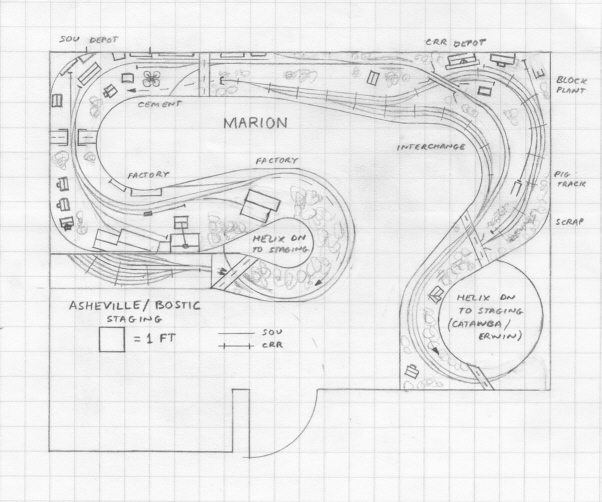- Size: 14′ x 20′
- Scale: HO
- Minimum Radius: 28″
- Minimum Aisle Width: 30″
- Designed by Dan Bourque
 Clinchcross, near Marion, NC, was a major interchange point between the Southern and Clinchfield. Besides playing host to several coal trains per day (particularly on the Clinchfield), Marion was a busy switching area for both roads. The Clinchfield stationed a switcher at Marion for years (don’t know about the Southern) to work the four-track interchange yard and industries which included a concrete block plant, a scrap dealer and a piggyback track among others. On the Southern side, the main industries were furniture plants which would see lumber in/furniture out. Marion also sat at the bottom of the grade to Asheville, so its sidings were used by through trains to set off cars to lighten the load to Asheville (I assume light power from Asheville would be dispatched to pick this up).
Clinchcross, near Marion, NC, was a major interchange point between the Southern and Clinchfield. Besides playing host to several coal trains per day (particularly on the Clinchfield), Marion was a busy switching area for both roads. The Clinchfield stationed a switcher at Marion for years (don’t know about the Southern) to work the four-track interchange yard and industries which included a concrete block plant, a scrap dealer and a piggyback track among others. On the Southern side, the main industries were furniture plants which would see lumber in/furniture out. Marion also sat at the bottom of the grade to Asheville, so its sidings were used by through trains to set off cars to lighten the load to Asheville (I assume light power from Asheville would be dispatched to pick this up).
The Layout
 This layout attempts to capture the feel of Marion in a modest space. It represents the town as it appeared from about the 1960s to the 1990s. One bonus is both railroads are fully operational, so if you can’t decide between the Southern and Clinchfield, then maybe you don’t have to! The biggest compromise is significant compression, especially for the Southern. In reality, the Clinchcross siding (east side of Marion where the interchange tracks join the Southern) was a loooooong siding, but on this layout, it will only fit about 18 cars, a couple of engines and a cab. Still, it offers a lot of operation and switching; however, the layout should be built low to allow good access to the CRR industries against the backdrop (three feet from the aisle and 4″ below the Southern tracks). Another bonus is that a double ended staging yard could be used to allow continuous running on both the Southern and CRR. Both railroads use both helixes, so it would be possible to use a single staging yard and single track helix with switches near the top for the CRR or Southern. However, I would recommend using two double-track helixes to allow continuous running on both railroads simultaneously. Also, because the staging width would be limited by the 27″ wide benchwork at Marion, double-tracking the helixes would allow the CRR and Southern staging to be stacked on different levels, effectively doubling the number of staging tracks.
This layout attempts to capture the feel of Marion in a modest space. It represents the town as it appeared from about the 1960s to the 1990s. One bonus is both railroads are fully operational, so if you can’t decide between the Southern and Clinchfield, then maybe you don’t have to! The biggest compromise is significant compression, especially for the Southern. In reality, the Clinchcross siding (east side of Marion where the interchange tracks join the Southern) was a loooooong siding, but on this layout, it will only fit about 18 cars, a couple of engines and a cab. Still, it offers a lot of operation and switching; however, the layout should be built low to allow good access to the CRR industries against the backdrop (three feet from the aisle and 4″ below the Southern tracks). Another bonus is that a double ended staging yard could be used to allow continuous running on both the Southern and CRR. Both railroads use both helixes, so it would be possible to use a single staging yard and single track helix with switches near the top for the CRR or Southern. However, I would recommend using two double-track helixes to allow continuous running on both railroads simultaneously. Also, because the staging width would be limited by the 27″ wide benchwork at Marion, double-tracking the helixes would allow the CRR and Southern staging to be stacked on different levels, effectively doubling the number of staging tracks.
Operations
This layout would be perfect for 2-3 operators, though one operator could still have a lot of fun. Operations on the CRR would consist of through trains dropping off cars for the Southern and an occasional meet using the siding. In between trains, the switcher would work the interchange and switch the industries on the CRR side. Without any knowledge of Southern operations in the area, here’s how it might go: like the CRR, Southern trains would meet using the siding. Some northboud trains (geographic west) for Asheville would drop off a few cars in the short siding adjacent to Clinchcross (or possibly even the short siding in Marion). A couple of times per day, light power (or power with a few interchange or local cars) might run down from Asheville (staging) to pick up the cars and haul them up the hill along with any Northbound interchange traffic. Some southbound trains would pick up additional cars from the CRR before heading to Catawba (staging). At least one local would come from staging to work the numerous industries and assist with interchange.
Things I Like About this Plan:
- Tons of switching
- Two railroads well represented
- Continuous running loop(s)
- Decent radius and aisles for a modest layout
- No duckunders
Things I Don’t Like About this Plan:
- Fairly compressed
- CRR industries hard to reach
- Short sidings
- Complex arrangement with two helixes and potentially stacked staging yards
Related Products:




